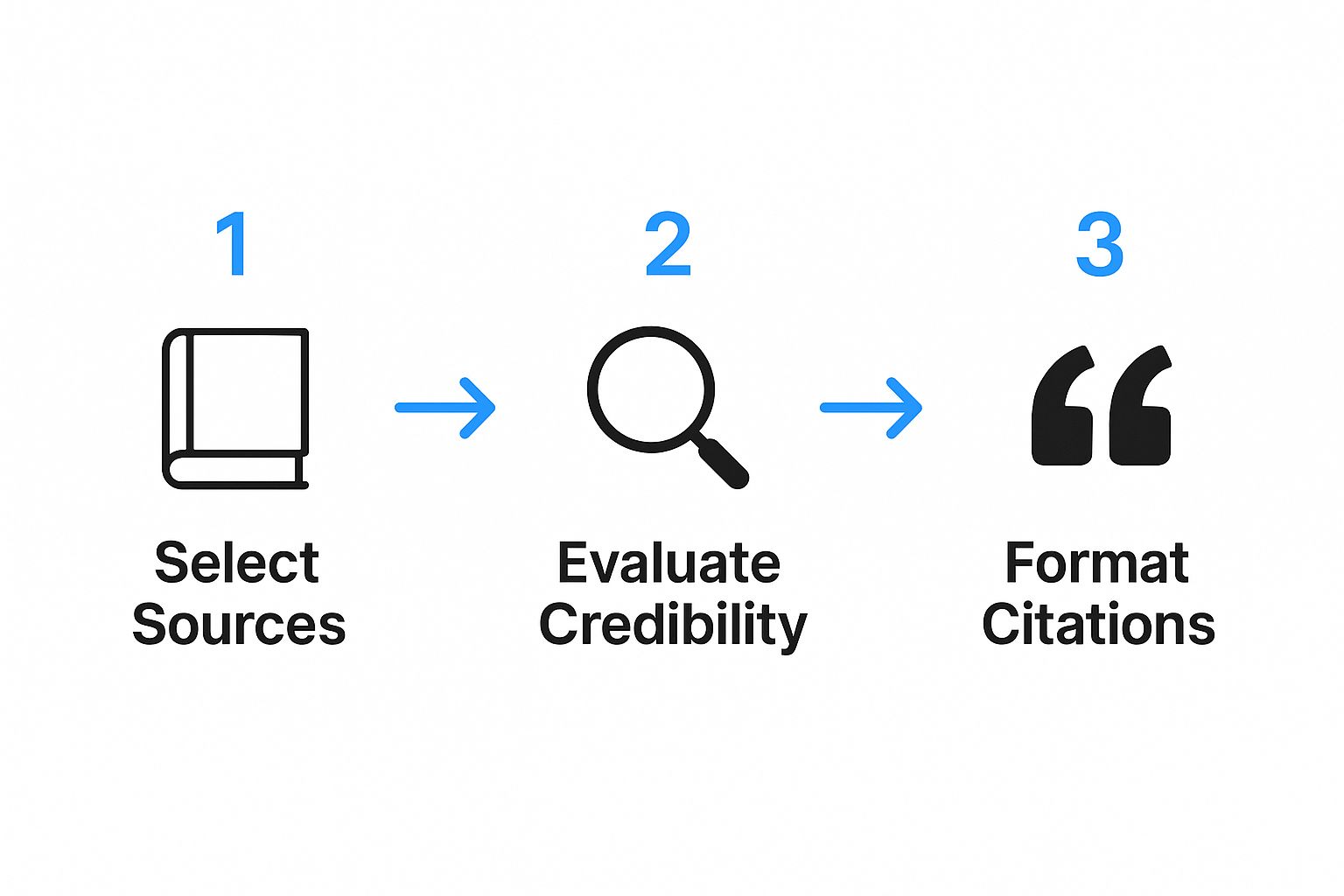How to Start Research Paper: Your Complete Success Blueprint

Finding Research Topics That Actually Excite You
Let's be honest, the blank page for a research paper is intimidating. The biggest challenge is often just figuring out what to write about. The secret isn't finding some "perfect" topic right away. It's about landing on a question that actually makes you want to find the answer. The most powerful research papers come from a place of real curiosity, not from a list of boring, pre-approved subjects.
Where Great Ideas Hide in Plain Sight
You probably won't find your breakthrough idea sitting in a silent library. It’s much more likely to hit you while you're going about your day. The best questions for research often pop up from things that make you feel something or ask "why?" Think about these moments as potential starting points:
- That news story that made you mad or just didn't make sense.
- An argument in class that ended without a real conclusion.
- Something you've gone through personally that you want to figure out.
- A podcast that dropped an idea you can't shake.
These are more than just random thoughts; they're your ticket into a larger academic discussion. Your interest is what gets the engine started, but you need to connect it to what others are talking about. And that conversation is global. For instance, China now publishes over 1.2 million academic papers each year, far outpacing the 766,213 from the United States.
This means fresh ideas and data are coming from all over. Knowing this helps you see where your idea fits into an active, worldwide conversation. Explore more about these global research trends.
From a Vague Interest to a Sharp Focus
Okay, so you have an idea that interests you. Now you have to turn that spark into a research question you can actually tackle. This is where a lot of students get tripped up, choosing something way too big or way too small. A topic like "the effects of climate change" is an entire library, not a single paper. On the other hand, "my uncle's weird gardening habits" is a funny story, not a research project.
You're looking for that "just right" middle ground. Imagine you’re into online gaming. Here’s how you could narrow it down:
- Too Broad: "The impact of video games on society." (Where would you even begin?)
- Too Narrow: "Why my friend plays League of Legends for ten hours straight." (Interesting, but it's about one person.)
- Just Right: "How have in-game social communities in massive multiplayer online games (MMOs) influenced the real-world communication skills of young adults?"
See the difference? This final question is focused, it presents an argument you can investigate, and you can actually find sources for it. This gives you a clear roadmap and the right keywords to start your research.
Writing Thesis Statements That Drive Your Entire Paper
Think of your thesis as the spine of your paper—it holds everything together. It's not just a box to check on your assignment rubric; it's the central claim that gives your writing purpose and keeps all your arguments pointed in the same direction. A flimsy thesis often results in a paper that wanders aimlessly.
The goal is to move beyond a simple statement of fact and create a focused, compelling argument that you can defend with evidence.
From Vague Fact to Sharp Argument
One of the most common traps students fall into is writing a thesis that’s just a fact. For example, stating "Fast fashion has a negative environmental impact" is true, but it's not an argument. Where do you go from there? It's a dead end.
A strong thesis needs to be debatable. Now, let's sharpen that idea: "While most criticism of fast fashion focuses on textile waste, its most profound environmental damage actually comes from the water pollution caused by unregulated dye-dumping." See the difference? This version is specific, arguable, and gives you a clear roadmap for your paper. It tells your reader exactly what you plan to prove.
Your Thesis Is Not Set in Stone
Don't panic about getting your thesis perfect on the first draft. In fact, your thesis should evolve as you dig into your research. This isn't a sign of failure; it’s a sign that you're actively engaging with your topic and thinking critically.
Consider your initial thesis a working hypothesis. As you gather evidence, you might find that your original claim needs tweaking or that a more interesting argument emerges. Letting your research guide your thesis is a key part of how to start a research paper that offers real, valuable insight.
To make this concept clearer, let's compare some weak thesis statements with their stronger, more argumentative counterparts. The table below shows how a little refinement can make a huge difference.
Strong vs. Weak Thesis Statements Comparison
Examples comparing effective thesis statements with common weak alternatives across different academic disciplines
| Subject Area | Weak Thesis Example | Strong Thesis Example | Key Improvement |
|---|---|---|---|
| Literature | The Great Gatsby is about the American Dream. | Fitzgerald's The Great Gatsby critiques the era's materialism by illustrating the moral decay of the American Dream through its characters' pursuits. | Specifies how the novel critiques the concept and what it reveals. |
| Technology | Social media is bad for teens. | The algorithmic-driven content on platforms like TikTok and Instagram contributes to heightened social anxiety among teenagers by promoting unrealistic and curated social comparison. | Narrows the focus to a specific cause (algorithms) and effect (social anxiety). |
| History | The Civil Rights Movement was important. | While the NAACP's legal strategy was crucial, the nonviolent, direct-action protests of SNCC in the early 1960s were more effective at achieving local desegregation. | Makes a specific, comparative claim that can be proven with historical evidence. |
Notice how each strong example takes a clear position. They don't just introduce a topic; they present an argument that needs to be defended throughout the paper. This is the foundation of a focused and persuasive research paper.
Research Strategies That Actually Save Your Sanity
Let's be real: "research" can quickly turn into a late-night panic session with dozens of open browser tabs and no clear argument to show for it. Smart research isn't about hoarding information; it's about finding the right information without losing your mind. Knowing how to start a research paper with a solid plan from the beginning is the key to avoiding that all-too-familiar chaos.
Master the Art of Digital Detective Work
When you find a genuinely good academic paper, don't just use it and move on. Treat it like a treasure map. The best sources almost always point you toward other great ones. Flip to the bibliography and see which authors or studies keep popping up. This trick, known as citation chaining, is how seasoned researchers quickly identify the most important texts in any field.
This skill is more important than ever. It's predicted that by 2025, a staggering 67.9% of the world's population will be online, which means the ocean of information is only getting bigger. You can discover more about our connected future here. While new AI tools can help summarize articles and analyze data, you have to use them correctly. Check out our guide on how to use AI without plagiarizing to make sure you're using them as an assistant, not a ghostwriter.
Build Your Research Headquarters From Day One
We've all scribbled down a brilliant note at 2 AM only to find it's completely incoherent the next morning. To avoid this, you need a central system for your research. It doesn't need to be fancy; a simple spreadsheet is perfect. Create columns for the source link, a killer quote, your own thoughts on it, and a quick rating for how credible it seems. This creates your own personal, searchable database for your project.
This simple habit does two very important things:
- It makes you think about a source's credibility right away, instead of after you've already written a paragraph based on a sketchy website.
- It gives you a bird's-eye view of your evidence, so you can easily see when you have enough material to build a strong case for your thesis.
You're done researching when your new finds just repeat what you already know. Your research should support your argument, not become a never-ending side quest.
Creating Outlines That Actually Guide Your Writing
Let's be honest, outlines often feel like a pointless assignment. You spend time creating one for your professor, only to completely ignore it when you actually start writing. But what if we saw it differently? A well-crafted outline is your paper's GPS, not just a quick sketch you turn in for points. It’s the very thing that stops you from getting lost in confusing paragraphs and ensures every idea supports your main argument.
Choosing Your Outlining Style
There isn't one perfect way to create an outline because everyone's brain is wired differently. For some people, a traditional hierarchical outline (the classic I, A, 1, a format) is the best fit. It’s a linear approach that makes you map out how your ideas relate to each other in a logical sequence.
For more visual thinkers, a mind map might be a better tool. This method lets you brainstorm freely, drawing connections between ideas as they come to you. It feels less rigid and can help you see your entire argument at a glance. The goal is to choose the style that feels most natural for you.
Building a Roadmap, Not a Cage
A solid outline is your best weapon against the dreaded writer's block. Instead of staring down a blank page, you’re looking at a series of smaller, more approachable prompts. It’s your chance to map out your argument, make sure your sections are balanced, and avoid writing long, rambling paragraphs that go nowhere.
A great outline is also meant to be flexible. As you dig into the writing, you’ll discover new information and fresh angles. Don't be afraid to adjust your plan. Refining your work is a natural part of the process, and you might find our guide on how to humanize AI-generated content helpful for that final polish. This planning mindset also applies to managing your research. As you gather sources, it’s a good idea to optimize your files without losing quality to keep your digital workspace organized.
Understanding What Makes Research Relevant Today
A great research paper does more than just earn a good grade; it joins a larger, ongoing conversation. To make your work feel important, you need to connect it to the real world. This means looking beyond academic journals to see what problems and trends people are actively trying to figure out right now. This simple change in perspective can turn a standard assignment into a work that feels genuinely significant.
Tapping into Real-World Conversations
A great shortcut for how to start a research paper is to follow the money and the headlines. For instance, the consulting industry, which guides major business strategies, is projected to grow by 5% in 2025. This growth is fueled by companies in healthcare and energy pouring money into new technology. Suddenly, a paper on how AI can fix pharmaceutical supply chains isn't just an academic exercise—it's incredibly timely. You can discover more insights into these market priorities here.
When you explore current topics like this, you'll naturally use a range of digital tools. It's important that your final paper showcases your own analysis and thinking. To keep your work original throughout the process, check out our guide on how to avoid AI detection in writing.
Blending Trendy Topics with Timeless Questions
Relevance isn't always about the newest fad. You can breathe new life into classic subjects by looking at them through a modern lens. Instead of another standard analysis of Shakespeare, what if you compared the gossip and social hierarchies in Much Ado About Nothing to modern influencer culture on social media?
This approach positions your work at the intersection of established scholarship and current culture, making it far more compelling. The goal is to find that perfect balance that makes your research feel both solid and exciting.
Building Research Timelines That Work in Real Life
We’ve all seen those perfectly color-coded schedules that map out a project down to the minute. And let's be honest, they rarely survive the first week of real life. The true secret to managing a big research paper isn't about a rigid plan but a flexible framework that can handle the unexpected. A key book might be checked out of the library, or a single article could send your research in a totally new and exciting direction. Your timeline needs room for that kind of productive chaos.
Start From the End
The best way to get a handle on your project is to work backward from your final deadline. Open your calendar, find that due date, and mark it in big, bold letters. Now, start blocking out chunks of time for the major phases: initial research, deep reading and note-taking, outlining, drafting, and—the part everyone underestimates—revising.
For a typical semester-long project, a good starting point is allocating four weeks for research, one for a solid outline, three for drafting the paper, and two full weeks for editing and proofreading. This reverse-engineering approach turns a single, intimidating deadline into a series of smaller, more manageable goals.
Embrace the Buffer Zone
Feeling overwhelmed is the main reason we procrastinate. The most effective defense is to slice your massive tasks into tiny, achievable goals. Instead of putting "Work on research paper" on your to-do list, try "Find three academic articles on my topic" or "Write the first body paragraph."
This strategy of creating small wins is a powerful way to build momentum. It's a fundamental part of translating research into practice and developing a workflow that keeps you moving forward, even when you don't feel motivated. Mastering this is the key to learning how to start a research paper without that all-too-familiar, last-minute panic.
To give you a clearer picture, here’s a sample timeline for a 10-week research project. Think of this as a template you can adjust based on your own project's complexity and your professor's requirements.
Research Project Timeline Template
A practical week-by-week breakdown showing how to allocate time for different phases of research paper development
| Phase | Duration | Key Activities | Deliverables | Common Challenges |
|---|---|---|---|---|
| Topic & Preliminary Research | Weeks 1–2 | Brainstorm ideas, conduct initial library and database searches, read abstracts and introductions to gauge relevance. | A professor-approved topic and a preliminary list of potential sources. | Finding a topic that is not too broad or too narrow; feeling overwhelmed by the number of sources. |
| Deep Research & Note-Taking | Weeks 3–4 | Read key sources thoroughly, take detailed notes, and organize findings by theme or argument. | An annotated bibliography and a well-organized set of notes (digital or physical). | Getting lost down research "rabbit holes"; managing and synthesizing a large volume of information. |
| Thesis & Detailed Outline | Week 5 | Formulate a clear, arguable thesis statement. Create a structured outline with main points and supporting evidence. | A final thesis statement and a detailed, logical outline for the entire paper. | Crafting a thesis that is an argument, not just a fact; creating an outline that flows logically. |
| Drafting the Paper | Weeks 6–8 | Write the introduction, body paragraphs (following the outline), and conclusion. Focus on getting ideas down on paper. | A complete first draft of the research paper. | Experiencing writer's block; ensuring smooth transitions between paragraphs and ideas. |
| Revision, Editing & Proofing | Weeks 9–10 | Revise for content and clarity, check all citations and formatting, edit for grammar and style, and perform a final proofread. | The final, polished research paper ready for submission. | Not leaving enough time for proper revision; confusing light proofreading with deep editing. |
The main takeaway here is to allocate specific time for each stage, especially revision. Rushing the final steps is where a good paper can fall short.
Your Next Steps to Research Paper Success
Getting a research paper off the ground can feel like a huge task. But with a solid system in place, you can transform that intimidating blank page into a focused, persuasive argument. The goal is to make these strategies feel like second nature, giving you a boost of confidence for any project that comes your way.
A Quick Recap for Your Workflow
- Find topics that you're actually interested in exploring.
- Write a sharp, debatable thesis statement as soon as you can.
- Build a flexible outline that will act as your roadmap.
- Carefully review and sort your sources.
This flowchart gives you a visual of the core citation process.
It shows that finding a source is only the first part—evaluating its credibility is a vital step before you even think about formatting.
Staying Confident and Focused
It's easy to lose steam during those long research marathons. Don't forget that your physical well-being plays a huge role in your mental focus. Setting up an ergonomic office can make a real difference, preventing the kind of physical discomfort that kills your concentration.
As you bring different research tools into your workflow, it's also smart to think about originality. Making sure your final paper is truly your own work is key. If you're curious about this, our article exploring if AI can really be detected offers some interesting insights.
Just remember, every expert researcher was once a beginner. Having the right tools just helps clear away the friction. If you're ready to sharpen your ideas and write clear, polished academic work, Word Spinner was built with students in mind. Start your free trial today and see how it fits into your process.



